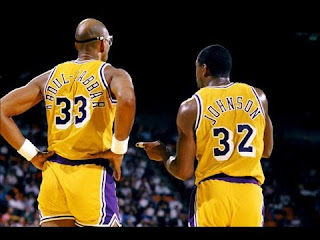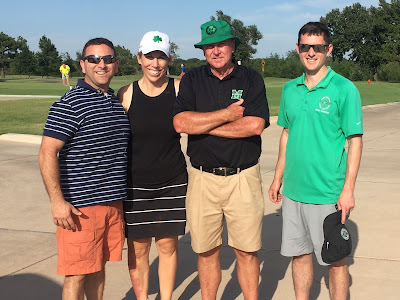Here are but a few brief thoughts and recollections from the evening that prompted the necessary change to my descriptor.
As many fans know, Abdul-Jabar is the all time leading scorer in the NBA. Let's make this a little more clear in case it's not already: No one has more points in his entire career than this great center does with 28,287 points and an average 24.6 points per game. The six time NBA Champion also won three NCAA championships at UCLA.
Though the list of his accomplishments is both lengthy and highly impressive, what touched me most is that so many people are pushing for him to win the Presidential Medal of Freedom. The session led me to believe that he was going to earn what is
"America's highest civil award. It is conferred upon men and women of high achievement in the arts and entertainment, public service, science, education, athletics, business and other fields. For most recipients, this award is a special distinction added to many prior honors."Unfortunately, I cannot find any evidence that it is confirmed. I hope he is included in the next class.
The emcee, Von Jones made me laugh when he said "Kareem, you are my tallest hero." I thought of the literal and figurative truth behind his words. Jones had the wisdom to ask who was Abdul-Jabbar's hero. When he said "Emmett Till" I raised my hands to clap and clap loudly.
Abdul-Jabbar was just eight years old when Till, a 14 year old boy was lynched for allegedly whistling at a white woman. "I couldn't and didn't understand," Abdul-Jabbar said. "But that story had a profound affect on me, even at a young age."
Till's legacy lives on when an American hero, like Abdul-Jabbar honors him and his mother. Mamie Till decided to keep her teenage son's casket open so the world could see. Till's life and his mother's decision paved the way for Rosa Parks and the Civil Rights movement. They are fitting and worthy heroes. Thank you Kareem.
Jones also pointed out that today, Abdul-Jabbar is the most visible and beloved Muslim in the west. Though I believe Mulala Yousafzai, (who now lives in the United Kingdom), might give Abdul-Jabbar a run for the money, I was struck by the poignancy of those words.
Abdul-Jabbar, who advocates for women's rights called out the injustices to women that he has encountered in his own faith. He referenced the inconsistencies between what the Quran says and how many Muslim countries proceed in their treatment of women. For example, "the Quran says that women are free to choose who they marry, the are equal partners in a marriage, that they have the right to inherit money and property." I am not sure in what way Abdul-Jabbar is responding to this inequity; perhaps his new book, "Writings on the Wall: Searching for a New Equality Beyond Black and White" does.
At this point in the conversation Jones pointed out that it has been written that Abdul-Jabbar is a teacher and philosopher trapped in a basketball player's body. Abdul-Jabbar didn't disagree. I appreciated his talk as much for his insights on Colin Kapernick's decision to sit during the national anthem as I did his tales from the hardwood.
He gave total respect to his coaches, including the great John Wooden. When he spoke about the Wizard of Westwood, his tone, his body language and his message was one of reverence. He said that the greatest lesson Coach Wooden taught him was the importance of being prepared. Though this doesn't sound either surprising or all that interesting, he elaborated quite eloquently on the point. Abdul-Jabbar admitted that he was always mentally and physically ready for the task at hand because of how Coach Wooden taught him to prepare. And what he appreciated about this teaching was that it was in no way limited to basketball. "He used basketball to teach us how to be prepared as a family member....as a husband...as a citizen...as a member of society."
Abdul-Jabbar got me to laugh when he admitted that he didn't understand Wooden's Pyramid of Success during his four years at UCLA. "I thought he was a Mason for a long time. Now I understand how it was related to Wooden's utter conviction of how important it is to do things the right way. He was totally committed to it. I attribute his way to his deep Christian faith."
There were many local cheers when Abdul-Jabbar admitted that no one played defense on him like the late, great Nate Thurmond. But I think there was even more enthusiasm when an audience member asked the leading question that delights all sports fans: "Who is the greatest Laker?" Ever serious, Abdul-Jabbar went through the list of who could be number one. He said, "it's a tough question. You can make an argument for Jerry West, Elgin Baylor, Wilt Chamberlain, Magic Johnson...some say me...others Kobe...." With his pause, there were both cheers and jeers until he said "but this is why they have sports bars! You get a beer and some wings and can debate this question for hours." Amen.
My favorite story from the evening was about his teammate of 10 years, Earvin "Magic" Johnson. The very first year this 1-2 punch played together, they won 60 games and clinched their first of five NBA titles. Johnson, the number one draft pick was so excited to play with Abdul-Jabbar that after their first game, he ran up to Abdul-Jabbar, leaned his arms against the 7-footer and celebrated like they won the title. Abdul-Jabbar said, "He looked like a pogo stick!" Again, he paused and then added "I told him the problem with that is Magic, we have another 81 games...it can't be like this every night. But I'm often fairly serious, and Magic taught me how to enjoy the moment."
The author of a new book Kareem Abdul-Jabbar's message for changing racial climate in this country was simple and practical: "get to know your neighbor." Though no longer a Christian, I could not help but the beginning of the parable, The Good Samaritan. In it, the lawyer asks of Jesus. "And who is my neighbor?" Fortunately Kareem Abdul-Jabbar has thought about this question long and hard many times before.
I'm grateful, I got but an hour of his time to hear some of his answers to the most pressing questions of our time. Weird and cool? Sure. Compassionate, thoughtful and grounded and rooted? Absolutely.
Photo Credit
Black Muslim
With Coach Wooden
Magic and KAJ

















